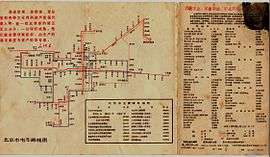Beijing Tram and Trolleybus


Trams (有轨电车) and trolleybus (无轨电车) in Beijing comprise part of the city's public transit infrastructure. The earliest tram service in Beijing dates to 1899 and street cars were the chief form of public transit from 1924 until the late 1950s until they were replaced by trackless trolleybuses that continue to ply tram routes, drawing power in the same way, from overhead wires. In the 1960s to 1970s, trolleybus buses were among the most important means of surface public transportation in the city and their routes expanded beyond the old city to the inner suburbs. Trolley bus expansion ceased in the 1980s with the growth of city buses with internal combustion engines, but electric trolleybus service has continued on more than a dozen lines and remains an important component of surface public transit in the city. In 2008, tram service returned to Beijing with the introduction of a tourist street car on Qianmen Avenue.
Service
As of June 2015, trolleybuses run on twenty Beijing Bus routes: Nos. 42, 101-109, 111, 112, 114-116, 118, 124, 127, BRT3 and BRT3 Shuttle(区间). [1][2] Most of these trolleybus routes are located inside the Third Ring Road. A tourist tram runs on Qianmen Avenue.
History
The oldest municipal trolley service in Beijing dates to 1899 when foreign interests built and operated a 7.5-km tram service between Majiapu and Yongdingmen.[3][4] The track was destroyed during the Boxer Rebellion in 1900.[3]


.jpg)
In June 1921, the city government established the Beijing Electric Trolley Joint Stock Company and used company shares to secure a 2 million dollar loan from Banque Franco-Chinoise pour le Commerce et l'Industrie to fund the enterprise.[3] Virtually all equipment were imported – the tram tracks from France, street car from Japan, power generation equipment from Sweden and Germany, and repair facilities from Britain.[3] Tram service commenced three years later on December 17, 1924.[3] Several hundred guests, foreigners among them, attended the inauguration at the southern end of Tiananmen Square.[3] A dozen street cars paraded along the 9-km initial tram route from Qianmen to Xizhimen.[3][5] City residents crowded along route to see the new vehicles.[3] Five years later, the number of routes grew to five, which were distinguished by the colors red, yellow, blue, white and green.[3] The street cars were for the most part well received by city residents, except rickshaw drivers whose business diminished considerably.[3] On October 22, 1929, the rickshaw driver's union clashed with the Trolley Company and rickshaw drivers swarmed into the Tram depot, and destroyed 63 trams, halting service for 18 days.[3]
In July 1930, the 6th Route, began service from Chongwenmen to East Zhushikou.[3] The outbreak of the Second Sino-Japanese War following the Marco Polo Bridge Incident ceased tram service temporarily.[5] On January 1, 1938, the 6th Route Branch Line began operating on the newly built tracks between Tianqiao and Yongdingmen.[3] Ridership averaged 129,000 per day in June 1942.[5] By 1943, the city had seven tram routes with a combined length of 46.65 km and 144 street cars in operation.[5] After the end of the World War II, the city’s remaining
During the Chinese Civil War, tram service diminished. Ridership had fallen to 60,000 to 70,000 per day. In March 1950, the tramline's ring route from Pinganli through Xisi, Xidan, Tiananmen, Dongdan and Dongsi was restored.[3] An eighth route from Hongqiao to Tianqiao was added in 1955.[3] By 1957, the tram service had 250 street cars in operation, reaching an all-time high.[3] Yet, trams by then were considered slow and noisy compared to other motor vehicles and was more expensive and cumbersome to expand service into newly developed areas of the city because they required the laying of track.[3] City planners looked to trolleybuses, which do not need tracks and do not require diesel fuel to operate. In the 1950s, Chinese petroleum production was limited and trolleybuses like trams could be powered from electricity generated sources other than oil.[3]
On October 17, 1956, Beijing's first trolleybus made a successful trial run from Xisi to Fuchengmen.[3] On February 26, 1957, the city's first trolleybus began commercial operation from Beichizi and Fuchengmen.[3] On August 22, 1958, the Beijing People's Congress voted to replace tram service inside the old city with trolleybuses and regular buses by October 1959, in time for the 10th anniversary celebrations of the founding of the People's Republic.[3] On March 9, 1959, workers removed tram tracks and power lines between Xizhimen and Xidan and installed trolleybus lines.[3] The next day, Trolleybus Line No. 5 began operation from Qianmen to Xidan, Xinjiekou and Xizhimen.[3] Tram service from Qianmen to Dongdan, Beixinqiao and Dongzhimen was replaced by Bus No. 24.[3] Tram service was rapidly phased out of the old city.[3] On May 6, 1966, the last car on the tram line between Yongdingmen and Beijing Gymnasium ceased operations, ending tram service in the city until the Qianmen Avenue Street Car began running 42 years later.[3]
See also
References
- ↑ (Chinese) 1月15日起,北京快3(BRT3)18米无轨电车陆续载客运营 " gongjiaomi.com 2015-1-15
- ↑ (Chinese) 116路10月31日实施"油改电" bjbus.com Archived December 9, 2014, at the Wayback Machine. 2014-10-29
- 1 2 3 4 5 6 7 8 9 10 11 12 13 14 15 16 17 18 19 20 21 22 23 24 25 26 (Chinese) You Long, "北京有轨电车史话" 《前线》 Archived January 9, 2009, at the Wayback Machine. 2008-03-06
- ↑ (Chinese) "当当车历史的开端" 2009-09-14
- 1 2 3 4 (Chinese) "北京公交车发展史" 2009-09-17
External links
| Wikimedia Commons has media related to Trolleybuses in Beijing. |